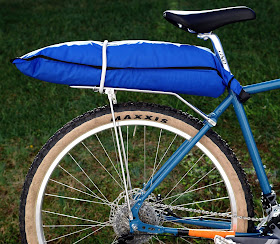By Scott, our winter expert
As VO's resident Canadian, I was requested to talk a little about winter projects. So with a blizzard approaching the mid-Atlantic ( 'Mericans call it a blizzard. I call it "heavy snow flurries"), I thought now was a good time to go over some ideas of ways to stay connected with the bike, considering the only riding I'll do this weekend is either on the trainer or on my Piolet.
Snow days give me a chance to look the bike over fully to make sure all is ready for the upcoming touring season. And with my increased gravel riding last year and plans for more gravel touring, it makes sense to ensure everything is ready to go and make the most of spring when it arrives.
The first thing I do with my winter break is to give my leather saddle some care and attention. Rubbing in some of the
VO saddle care helps protect the leather. If you just bought a VO saddle, keep in mind that our saddles come with a waterproof spray applied to their tops; the waterproofing helps protect the saddle during the shipping from Taiwan. It takes about a month of riding for the treatment to wear this off, so don't bother applying the VO leather care until you've ridden it for a month or so.
After the saddle has some wear on it, you can apply a dab of the saddle care to a nice clean rag and rub it into the leather. You don't need to use a lot of it; a little dab will do you, as they say. You can also use the saddle care on boots or such. It is made by Limmer boots for us, and we've all used it on leather boots for ages to keep them in tip top shape. There's more about VO saddle care in
this older blog post.
Moving down the bike, there are lots of bits on my bike that are, well, shiny. So this is where
Simichrome comes into its own. You can use it on a ton of stuff. I've used it on fenders, crank arms, stems and my Opinel knife to get them all looking nice and clean and shiny. It's also great for restoring classic parts as
Chris explains here.
Next, I check over the
brake pads and make sure they have enough life left on them and replace, if necessary.
I also take the down time to go over some of my camping stuff that has been in storage for the last couple months, clean it up, and check that everything is ready to go for future adventures. I give all my camp knives a sharpening with the
Opinel shaprening stone. I also give everything else like mugs, sporks and bowls a good wash and dry and put them back in their stuff sacks, so they can be grabbed quickly and with the knowledge that they are ready to go.
Other then watching cycling movies on Netflix, what are your snow day projects?



































